A bit drone-happy, but a lot of beautiful shots.
Category: Travel
Camping at Cape Lookout – South Core Banks
(I actually took this trip back in July of 2017, and originally posted some of the below on the expedition portal forums.)

Secluded. Windy. Sandy. Oceany. Cape Lookout has everything you love and hate about the beach, to the nines. Except crowds & lifeguards. There are three major islands – the North Core, South Core, and Shackleford banks. We stayed on the South Core banks.
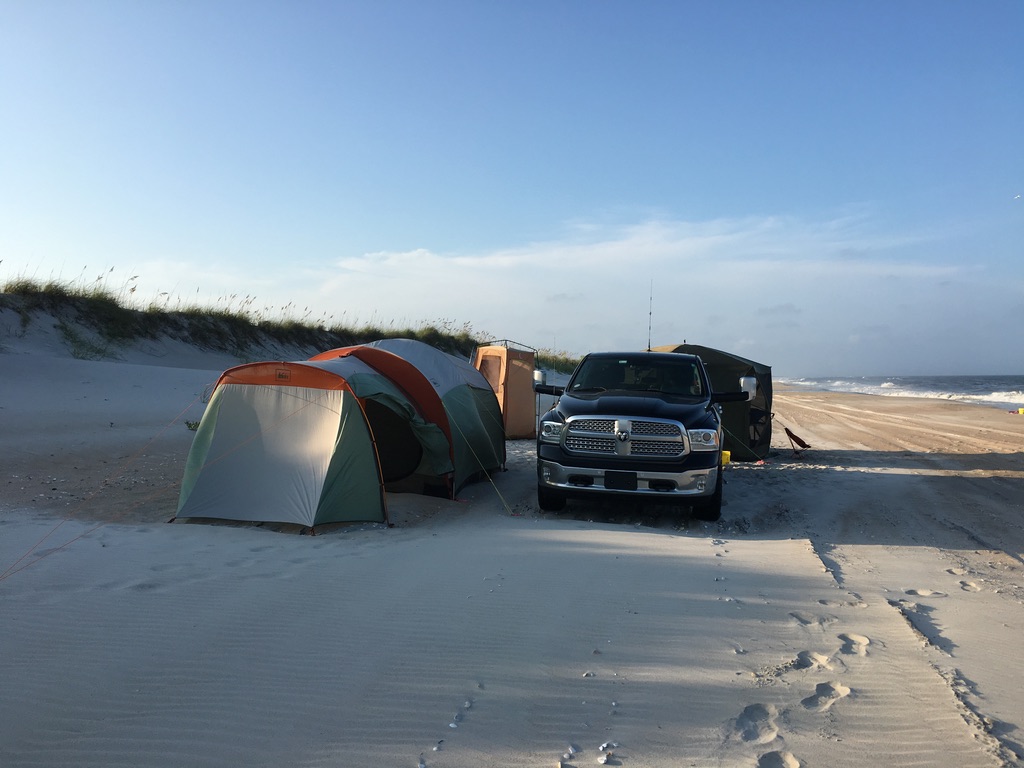
Like kites? Lots of wind, and plenty of space, and no one in the way.
Fish? I don’t fish much, but I was tempted to get a rod and license and give it a try. Judging by the rod covered vehicles driving by every morning, the fishing is good.
Shelling? Quite good along the southern tip. Not so great, but not bad, where we were camped.

Sitting around emptying beverage cans while doing nothing except watching the kids, the birds, and the waves? Perfection.
Getting pummeled by huge waves while worrying about deadly rip currents and sharks? More than I could want.
The surf was really strong – too strong for real swimming – on the ocean side. Didn’t run into any rip tides1 or long shore currents, but the waves would knock the kids over easily. They loved it2. The waves on the sound side were much, much, much less. Really, no waves to speak of. Lots of people though, and handy showers to rinse off along with a little gift shop that sells ice cream. We used both the ocean and the sound, and enjoyed both.
When the wind kicked up we got sandblasted. I got used to it quickly, but it gets the sand into even more places. Sand gets everywhere but I got used to that too for the most part. The key was to avoid surfaces where sand is really apparent – like a bare sleeping pad. The fleece slipcover I made did a good job of hiding the sand from me. They say bring a wisk broom, but really several would have been handy. We had one, and it was always somewhere else when needed.
Watch those tides
When we arrived on Sunday we chose a spot around mile 38 in the afternoon and settled in. Because it was very windy it took a while to get the tent up and secured, then the Goddess (see below) and the potty tent.
By that time we had high tide coming in and it was getting surprisingly close to where we were camped. My wife looked up a tides app, and said it was two feet below high tide. Oh poo.
At this point I was pretty beat, tired, and sweaty. I hadn’t set our tent up in a serious wind before and while nothing really went wrong it took a lot longer than expected and only time shows how sturdy a ground anchor is. We were relying on a lot of ground anchors. Doubt was creeping in.
Then the tide shows up and looks like it’s going to wash us away. I was trying to remember when the last ferry of the day was leaving as I double checked the tide.
It turned out the reporting station Susan was reading was from the sound side, not the ocean side. We were only 6 inches away from high tide, which was acceptable. We never did get wet, but it got within a few feet of us. A tidal pool formed next to the truck 😎
Not bad, but not the kind of surprise you need when doing this for the first time!
The new moon was the culprit – it brings a much higher tide than usual.
Bugs
I was sitting down for the first time after setting up camp, with a beer in hand, and I said “Wow Honey, the bugs really aren’t too ba…Son of a <bleep>! Holy <bleep>!” I leapt out of my chair and did an involuntary high speed martial arts montage as I felt a red hot electrified knitting needle jabbed into my tender hide.
I noticed the large green striped fly clinging to me like an ugly hooker in a red light district, continuing to snack on my flesh. Still thrashing around I finally I hit her hard enough to daze her enough to get her under foot for a proper coup de gras.
Apparently I have not been exposed to this type of biting fly before. They’re tough, persistent, and bite like a freaking tiger. Fortunately they hang on so they are easily killed once they start to bite. Also, they don’t handle wind very well, and even a 5-10mph breeze keeps them on the sand. The Thermacell did a good job of keeping them confused, and once I sprayed the Goddess with permethrin they were pretty much out of the picture.
I did get bit a few more times, and strangely it never again hurt like that first time.
No mosquitoes to speak of, or other biting insects.
Protect your feet
Up in the dry sand around camp we got used to going barefoot very quickly, but two of us cut our feet. This is not a good place to get a cut on the beach. All healed well enough, but I was limping sore until I finally relented, cleaned things up, and applied bandages.
The Green Goddess
Before our first trip of the season, to Natural Bridge, Susan insisted I get a screen tent. I had resisted a long time, being a confirmed tarp guy, but I could see our camping days would be over unless I produced so I commenced to researching.
I ended up buying a 35lb behemoth called The Clam. It is very large when packed, but it makes up for that by being heavy as well. About the size and weight of a large area rug rolled up with a body inside.
It also goes up quickly and is sturdy. As soon as Susan saw it she dubbed it the Green Goddess. The Green Goddess turned out to be another trip saving purchase. While even moderate wind will push in the sides or collapse the roof, it stayed up with several guy lines and by adding a central pole, even in 30+mph winds, well past reasonable tarp weather, and provided great shade and shelter from wind and blowing sand. Without it we would have had to live with just a tarp, which would have been nearly a full-time job to keep up with the wind we had, not to mention the noise and lack of wind protection.
Nemo Heliopolis – aka potty tent
Overall, this was a bit disappointing.
The steel frame is strong and has steel cables holding the sections together. It rusted at the joints, and the sections on one pole became glued together.
The tie down points are halfway up on the tent body, and are just simple web loops.
Ventilation is fair. The upside is that there is no fly to worry about, the bad news is that it can get hot inside. The only ventilation is a large screen window with an adjustable cover on the inside. Depending on wind direction you can get great air coming through, or not much.
The floor is basically poly tarp material, not removable.
The toilet paper holder worked pretty well, better than I expected. The mountain money stayed dry despite showers and was easy to get to.
There is nowhere for a kid to put their towel. The elastic pockets up top are convenient for adults, but kids can’t reach them. the work around is to hang them over the straps holding the frame clips.
The privacy zipper feature that allows for the zipper to be locked from the inside had me wondering – if you’re in the middle of nowhere with folks who you can’t trust not to unzip the tent while you’re in it…you’ve got bigger problems than someone unzipping the tent while you’re in it.
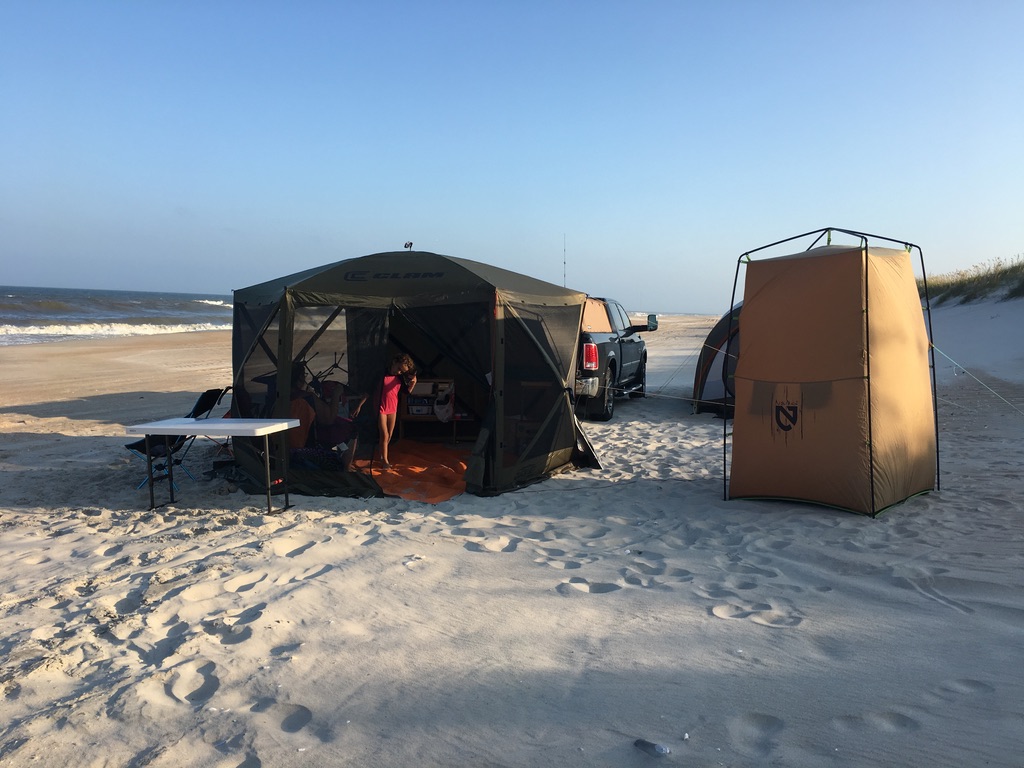
It stayed up in all weathers with three corners out of four guyed out. One pole bent a bit, and one had a few joints glued together via salt/sand/rust. Once it dried out I got it apart, but it was basically welded the day we took it down. The stakes that come with it are the usual joke – a 6” piece of 1/8” soft steel wire with a 100degree bend in one end.
Worth $150? Meh, I wish I had taken a closer look at the cheaper alternatives. The overall construction is long on clever features and short on robustness.
UPDATE: I’ve since bought a new pole set for this which is aluminum, and seems a lot nicer than the steel poles they used to use. Surely it’s a lot lighter, but I haven’t had it out in serious wind to test them.
Helio shower
The Nemo Helio shower worked well. My wife and the kids were very happy to have it. They all have long hair and they washed it easily. It does a good job of maximizing water use while giving a usefully strong spray.
The bad is that it comes in a fiddly bag that is too tight and water proof (why? Why not a sensible mesh bag?) and the pump mechanism isn’t very tolerant of sand. I could tell that the valve that makes the foot pump work was getting sand in it because I could hear it leaking when I pumped. The shower still worked, just not quite as well. I rinsed the sand and all was better. I was far happier with the shower than the shower tent.
Thetford PortaPotti
After bathing the next hurdle I had was providing a toilet – the girls were simply not going to use a hole in the ground. Frankly, I didn’t want to either.
So I got a Thetford PortaPotti 550p as the solution. It worked pretty darn well. Normal toilet height, and everyone was willing to use it. It did, however, develop an odor. Not a good one. Susan was the first to complain, but then it was obvious. I used the deodorant they provided, but still the potty tent smelled like a sewer.
I explained that I had tested the unit at home – indeed using both normal functions, and left it to ferment for a few weeks and no smells were apparent. Could it just be that my personal feces are not odiferous? Susan made it clear that was not the case.
I believe the cause is that the unit does not have a standing pool of water like a normal toilet to keep the unintentional residue of usage, aka skid marks, from being exposed to air. A quick wipe and things improved. When I removed it from the truck this morning it was not very smelly at all.
About the only thing I don’t like about this unit is that there aren’t handles for carrying it. Which means you’re bear-hugging a box full of excrement, which is a heckuva thought.
Pro tip: When emptying, do not – seriously, DO NOT – press the vent button until the unit is elevated or you will end up with a handful of something you definitely do not want a handful of.
Pro tip #2: Have handy wipes within reach.
All jokes aside, if you’re a parent you’ve already dealt with far worse than emptying a portapotti.
Stakes are really important
Normally I use a mix of the standard 10” steel stakes that are basically a large nail with a plastic top, and Snow Peak #30 stakes. Neither have let me down in normal soil, and I figured they’d be ok for sand.
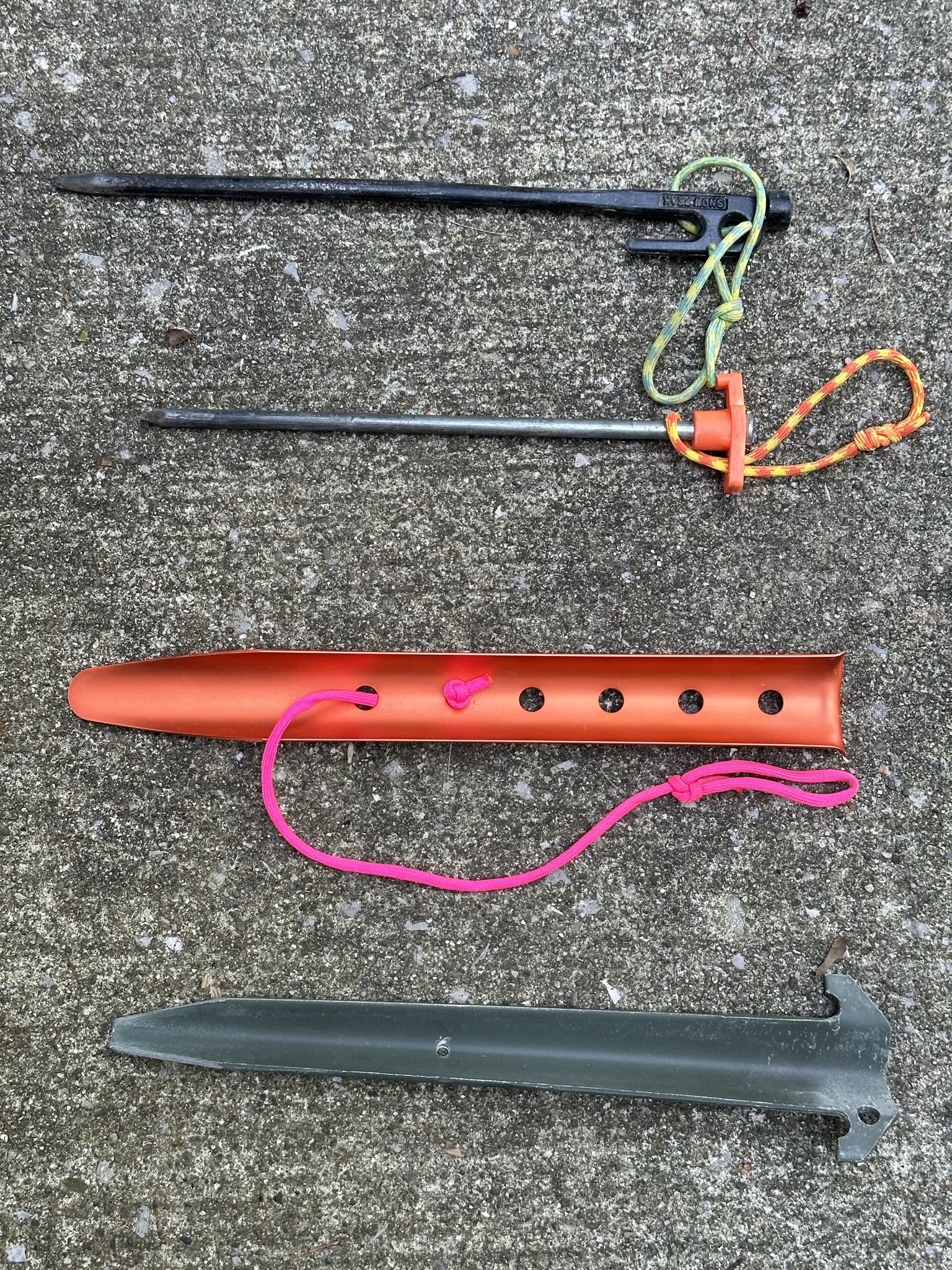
Fortunately at the last minute I decided to spend some money getting some sand/snow stakes from Amazon, along with some military stakes from Coleman’s Surplus. It would be a trip-saving move.
I really wanted to get the MSR ToughStakes, but they were just too expensive ($45 for a stake?!?). So instead I used the same concept with the much less expensive snow stakes from Amazon, which worked very well.
I routed a cord through the bottom hole, about 3” up from the bottom tip, back through the smaller hole just up from the bottom hole and then into a figure 8 stop knot. A bowline at the other end for a loop. This put the pull well below ground and near the center of the stake. In use the stakes got sucked under and disappeared from the surface. Just the cord would be coming out of the ground. It’s that being pulled down into the firm damp sand that made them work so well.
They kept a 16’ Kelty Noah’s tarp up in a 20mph wind, and kept our tent and shower tent up through higher winds than that. Easy, cheap and effective. I have no doubt the MSR ToughStakes work better, but they’re 10 times the cost or more.
The military stakes are clearly superior to the nails, and probably even the Snow Peaks. Much, much better in sand, and I bet they’re drivable into the usual clay soil/soil gravel mix I run into. I drilled them about 3/5 of the way down from the top to route cord through like the snow stakes, but didn’t end up using them that way.
Reflective cord and more cord
I will never use anything but brightly colored reflective cord for guy lines (or pretty much anything else) again. I will also use the taught line hitch instead of the silly plastic adjusters that came with our tent. Properly taught lines I can see are much better than getting clotheslined by sagging lines I can’t see.
I normally bring four 25’ hanks of reflective cord for the tarp, and another 50’ hank of regular cord for a clothes line (doubled and twisted so clothes can be tucked in the twists) and another two 25’ brightly colored hanks just in case.
This time I brought that plus four more reflective hanks to guy out the shower tent, and another six of tan and dark red cord I had lying around just in case. Plus a total of 24 orange snow stakes, and 24 OD military stakes.
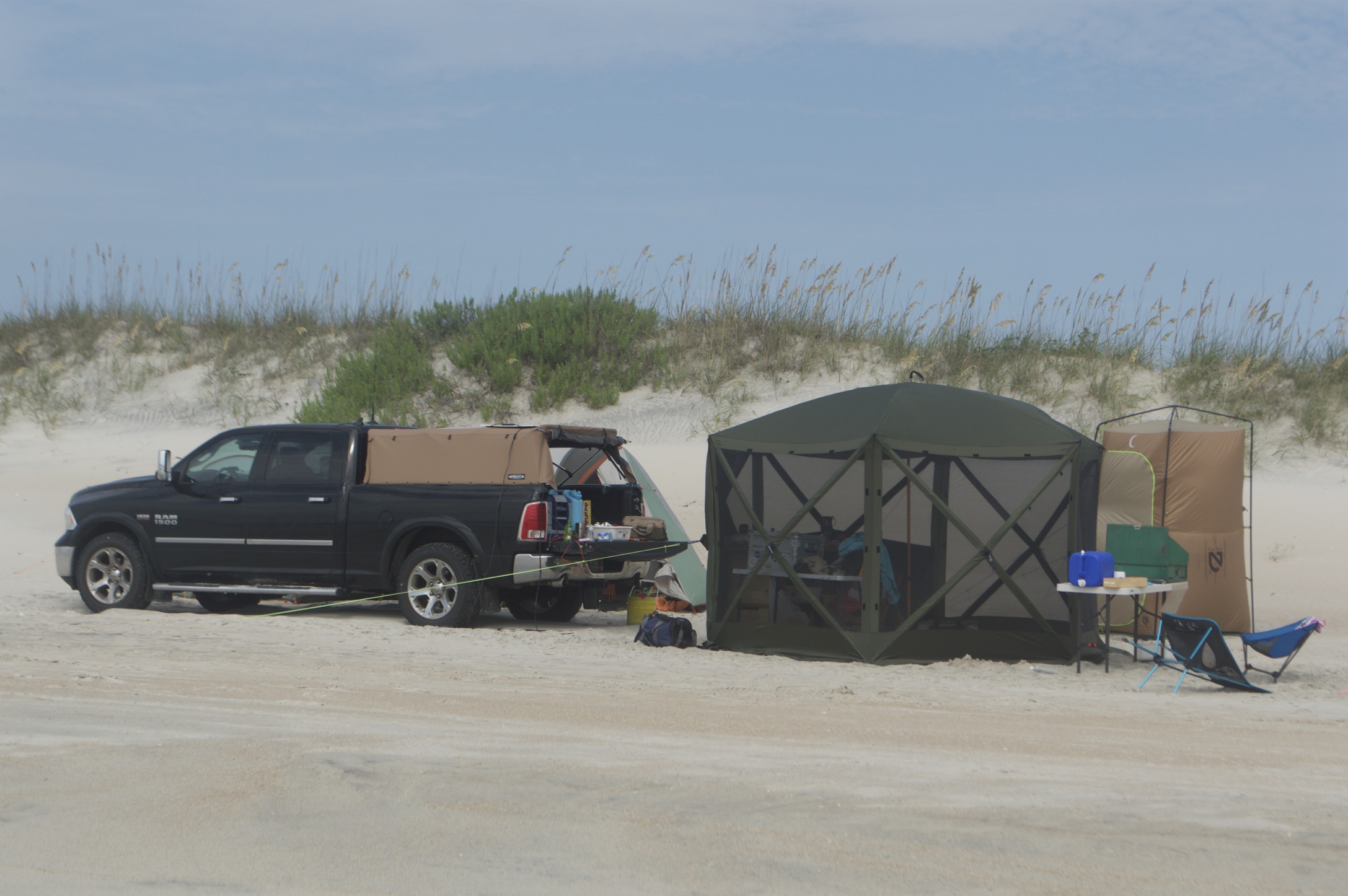
I used all the cord, and all but maybe 6 of the stakes. I used only 8 of the Snow Peak stakes, and none of the nails. Without the new stakes and extra cord, we would have been re-errecting collapsed gear continuously.
Mileage was terrible on sand
We used over 3/4 of a tank of gas driving around, and we didn’t drive all that much. Most of the consumption was on the first day when we drove the island top to bottom to decide where to stay. We got between 5 and 10mpg, with the lower end being far more common.
Never got stuck, or even close. If you’re looking for epic wheelin’ you’ll be left wanting I think. That said, the saltier looking truck campers, the ones that clearly had been out there often, were sporting tow straps and shovels in convenient locations.
I ran BF Goodrich all terrain tires, at about 20psi to increase the contact patch. I’ve since learned that street tires are preferred because the less aggressive tread doesn’t dig so quickly when the tire spins. Apparently there’s no bottom to that sand so you don’t want to go looking for it.
The air hose at the Cape Lookout ferry company is about useless and I gave up on it. I should have just used my compressor during the ferry ride to air back up, but we were in a hurry and I ended up doing just that on the next ferry to Ocracoke.
The ARB Fridge Rocked
Even though they sell ice on the island I couldn’t imagine doing this trip without a fridge.
We ran 4 or 5 gallons of water, at least, through the fridge in Nalgene bottles for drinking. The local water didn’t taste too bad. When it is 90 plus degrees with humidity to match, 35 degree drinking water doesn’t have to be Evian 8-).
Chocolate, even the hard 70% stuff I like, quickly turned to liquid and anything with it had to go into the fridge. Also we accumulated quite a lot of water in the bottom of the fridge just from condensation. The drain took care of that.
Running that much drinking water through the fridge, along with it being exposed to sun more than it should have been, was a bit of a torture test. I brought 100w of solar to power it but we ended up driving somewhere every day so the solar was not the only source of power. 100w of solar wasn’t enough. Maybe 150w would have been, 200w would have. The fridge used over 700wh per day at the beach, and 1.2kwh on the ride home. Inside my rather warm garage at home I was seeing more like 400wh per day, which I’d thought was a good test. Outside another trip to the beach or a desert I doubt I’ll see that kind of power consumption again, but it does give credibility to those here who say 100+ah plus of battery & 200w of solar are needed for a reliable fridge system.
I will be getting a fridge slide. Before the trip I agonized about whether to get solar or a slide. I chose solar. Should have chosen the slide.
UPDATE #1: Since then I’ve learned that the fridge is more accessible with a stool to stand on, and it means moving it in and out less. The stool also gives better access to the rest of the truck, and is much cheaper than a slide.

UPDATE #2 on our western road trip I used a 100AH lithium battery and the fridge was worry free. But that’s another blog post.
Water consumption
We brought 35gal of water but 25 was enough capacity to keep getting water from being a pain. We filled up 30gal while we were there, and left with 25. So we used about 40gal from late Sunday until Thursday morning, with two adults and three kids including bathing. We used seawater to wash dishes, fresh to rinse.
I used Scepter water cans and took two black water cans for bathing/cleaning water, and four civilian blue cans for cooking/drinking along with a Coleman container with a spigot for dispensing and hand washing.
The idea was the black cans would heat the water up in the sun. It worked pretty well – got the water up over 100 degrees.
But what did you do?
Flew kites, played in the surf, swam in the sound, a bit of shelling at the point. Really, not much. That was the point of going, actually. Sunsets were nice, but sunrises were nicer. I could spend all day siting and watching the ocean. My girls can spend all day playing in it.
We also drove through the “village” of houses from folks who had been living there in the 70’s, and it was fun to consider what it would be like to live there while looking at these old buildings.
What I liked best, and figured I would like best, is that there isn’t a whole lot of structure or rules. Yes there are signs about where you can and can’t go, but it’s common sense stuff and I don’t mind giving a turtle nest or bird nest some space. The seclusion was what I was after, and I got it.
I’d read about oppressive rangers, but we only saw one drive by on a quad every morning, and then back every evening. She waved when we waved, but otherwise paid us no mind.
We left the dog at home – thank God! She’d have been miserable in the heat, and it would have been very hard on her paws.
Getting home
We left Cape Lookout on Thursday, and drove to Cedar Island and took the ferry to Ocracoke. We got there, saw the lighthouse, and learned there was a power outage. So we took the ferry to Hatteras to see that lighthouse on our way to the Outer Banks.
We had reservations for a campsite at Oregon Inlet, so the power outage wasn’t a big hassle. It just kept us from having some ice cream on Ocracoke.
Oregon Inlet was more of a typical southern campsite – small. Burrs on the ground all over (site A26, should have chosen better but it was nearly dark when we arrived), but reasonable showers and bathroom. We really only slept there.
Friday we did some shopping, drove north to the beach at Corolla and drove up there a ways to see the horses, and then more shopping. In the evening we met up with a photographer on a beach for family pics, and then Saturday morning we headed home.
Going back
Will I go back to Cape Lookout? Heck yeah. However, as people have suggested, July is a tough time to be there. The wind mostly kept the bugs at bay, but between sweat, wind, and sand, I’d prefer to pick two instead of having all three.
Getting away is a skill
For some folks, namely me, getting away is not a natural ability. It takes effort.

I see now that the trip we took recently was way, way overdue. I was basically paralyzed to even plan the trip beyond a rough route and the first few stops. Thankfully my wife took over and organized stuff before we got too far, but clearly I shouldn’t have let myself get to that state before going.
You’d think vacation would be easy to remember to take, but in my case if I miss the window it gets over-though, it becomes overwhelming, it doesn’t happen, and the downward spiral begins.
How do you make sure you get away often enough?
The allure of hard tack – making a durable, edible travel biscuit
Between reading Aubrey/Maturin novels and watching Townsends videos on Youtube, I’ve developed a bit meme-lust for hard tack.
Hard tack is flour and water and salt formed into cracker or cookie shapes and baked and dried until it is basically rock-hard, and is a very durable food source used as far back as humanity has had flour, water, salt, and fire.
Why the allure? We all want food to be handy, but food so often requires a bit of care – it has to be kept from heat and cold and moisture or dryness and from being crushed. The idea of a perpetually edible, super durable, cheap to make cookie to carry while traveling or hiking camping or whatever is attractive. The vision of pulling out a small sack, fishing out a “ship’s biscuit” and having a quick snack is comforting. More so if said biscuit is made with whole, nutritious ingredients, which gives the thing that strong combination of being healthy and traditional. What could be better?
Well, based on my first experiments making this stuff, anything would be better. Hard tack is so hard it is not edible. It ain’t no cookie. I wasn’t surprised as most historical accounts I’ve seen have people using hard tack not so much a food by itself but as an ingredient in stews, soups, puddings, etc. It has to be crushed and/or soaked in liquid to be chewable.
But surely there is something nearly as hard but more edible, right? I mean, in the hundreds of years since hard tack was commonly used surely someone has developed something with most of the durability of hard tack but with a bit less fired-ceramic nature?
Enter Pilot Bread
While I was surfing around reading about hard tack recipes and looking for variations I learned about Sailor Boy Pilot Bread. Apparently this is a form of hard tack that is consumed in great quantities all over the state of Alaska, where regular bread is hard to come by. There are sites with recipes using it to make pizza, and apparently it is a delivery system for every kind of dip or spread. This is clearly more edible than actual hard tack.

Reputed to be durable, very shelf stable, and well-liked I thought I should get some and try them out. Easy thought, hard to get done. Sailor Boy Pilot Bread is hard to come by outside of Alaska. Amazon lists it, but says it is no longer available.
The company that makes Sailor Boy Pilot Bread that is listed on the package, Interbake Foods, is apparently defunct. Or maybe has become Weston foods, but their phone number is disconnected as well.
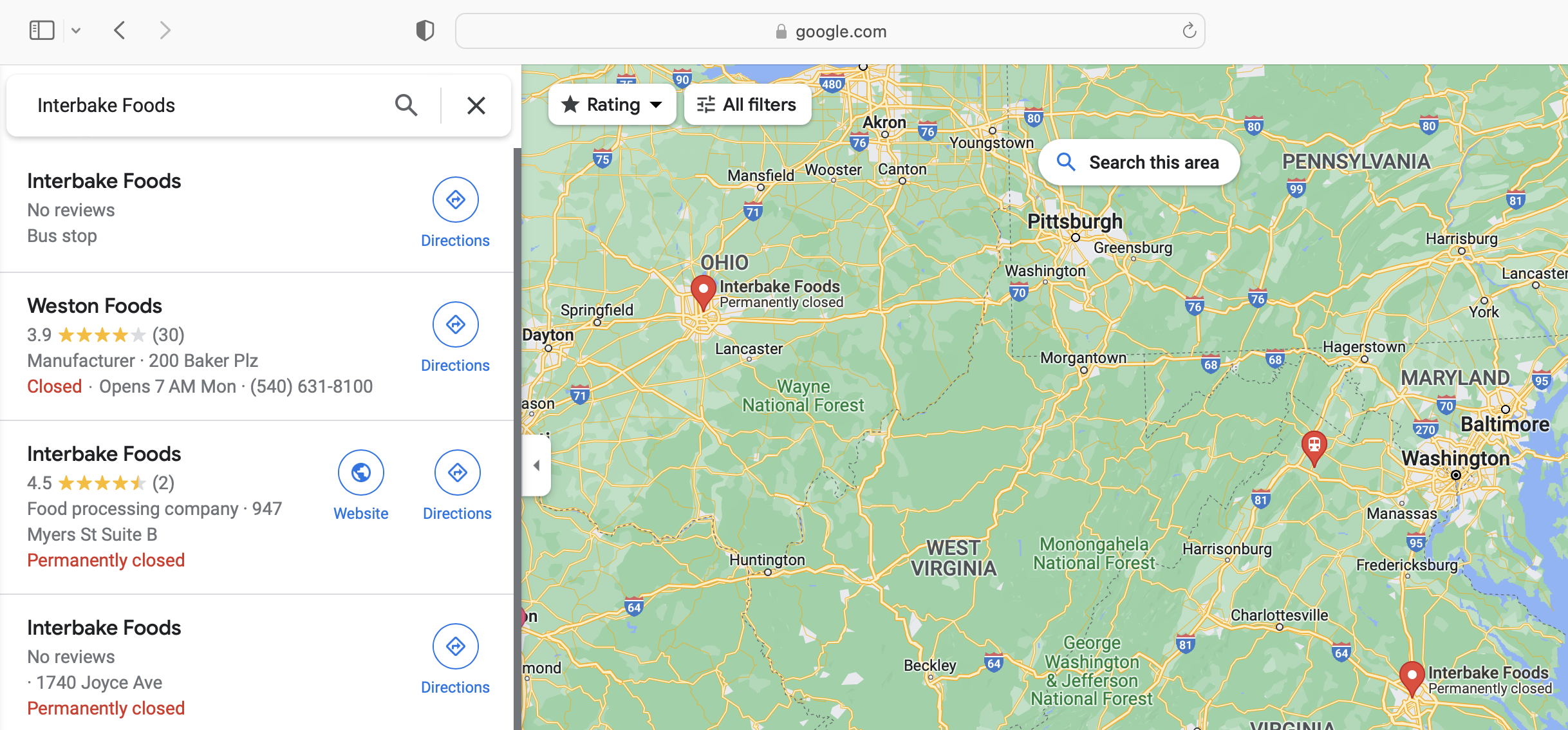
Maybe they are actually Hearthside Food Solutions (from Baking Business)

That number was dead as well, but I’ve emailed with no reply yet. And no mention anywhere of the Sailor Boy brand. Very mysterious.
Then I received this photo from a friend in Alaska:

So Weston it is! Or at least was in 2021.
While I wait for a reply from corporate America, I decided to try making my own pilot bread. I started with the recipe here: Grandpa Cooks
Attempts #1 & 2
I had doubts because the ingredients list was flour, water, salt, and baking powder – was the addition of baking powder really going to make a big difference? No it did not. Failure. Complete failure. So hard, even in a 1/8” thickness, that I was worried I’d break a tooth. Pistachio shells would be comparable, probably softer. Grandpa may cook, but not well. Or, possibly, Sailor Boy Pilot Bread is one hell of a lot harder than I’m thinking it is. No, can’t be, people eat pilot bread with salmon spread on it. It’s got to be softer.
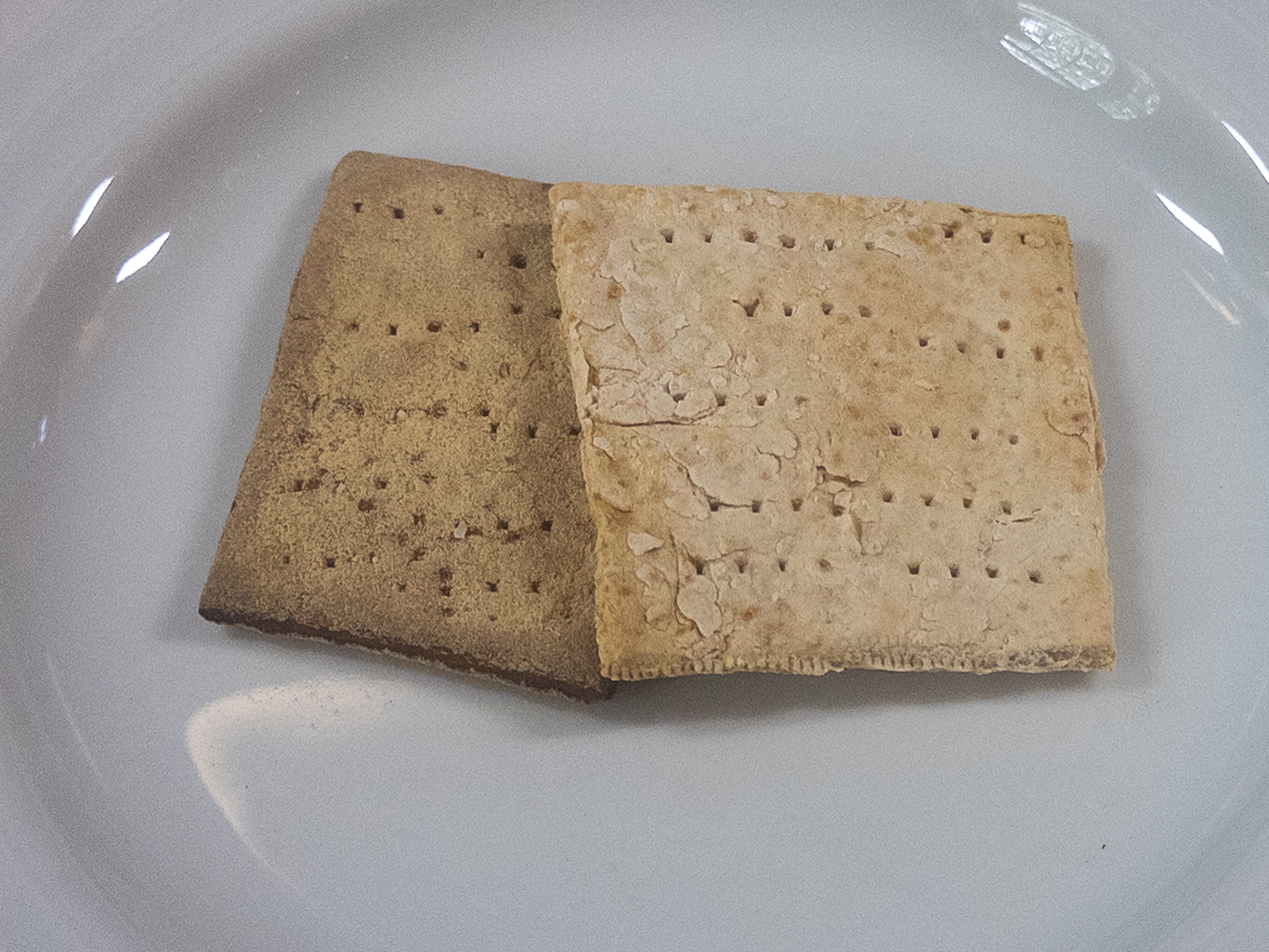
Looking at the ingredients list for Sailor Boy Pilot Bread, available a lot of places like on Food n flavors, we see palm oil as the second ingredient. I don’t have palm oil, but I do have coconut oil, and that is a tropical oil and has pretty good shelf stability.
Attempt #3
Adding a substantial amount of coconut oil was a game changer. This result was still very hard and crisp, but chewable without risk of damaging anything. Just a smidge harder than most anything else. Bland, but that is kind of the point. I suspect this recipe is not too far off from actual Pilot Bread, except for being ugly. This recipe would serve but it might be nicer to get more leavening. And flavor, and fiber.
Attempt #4
Involved doubling the amount of baking powder with no discernible difference.
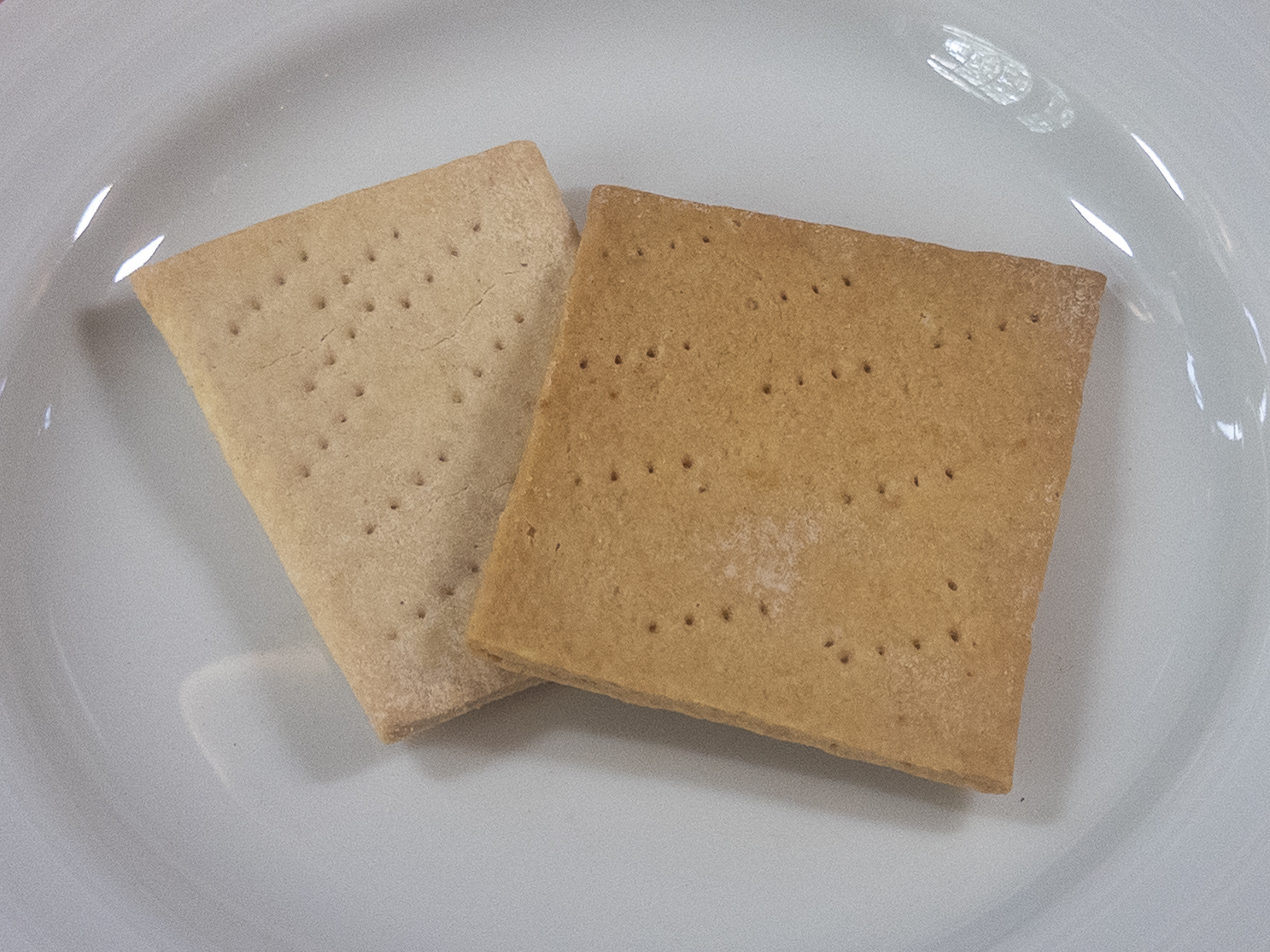
Attempt #5
Part of my plan was to incorporate whole wheat flour to add flavor and fiber, so I added 50% whole wheat flour, and upped the water the make the dough a bit softer. Attempt #5 yielded a slightly softer cracker yet with more texture and flavor, and very close to what I originally had in mind. I also started making them round rather than square, but I’m trying to decide if that is really worth the trouble. This result lacks the refinement of store-bought crackers, being a little ugly and not perfectly round and consistent, but the flavor is pretty comparable to crackers I’ve had in the past. Easily edible alone or with other things.
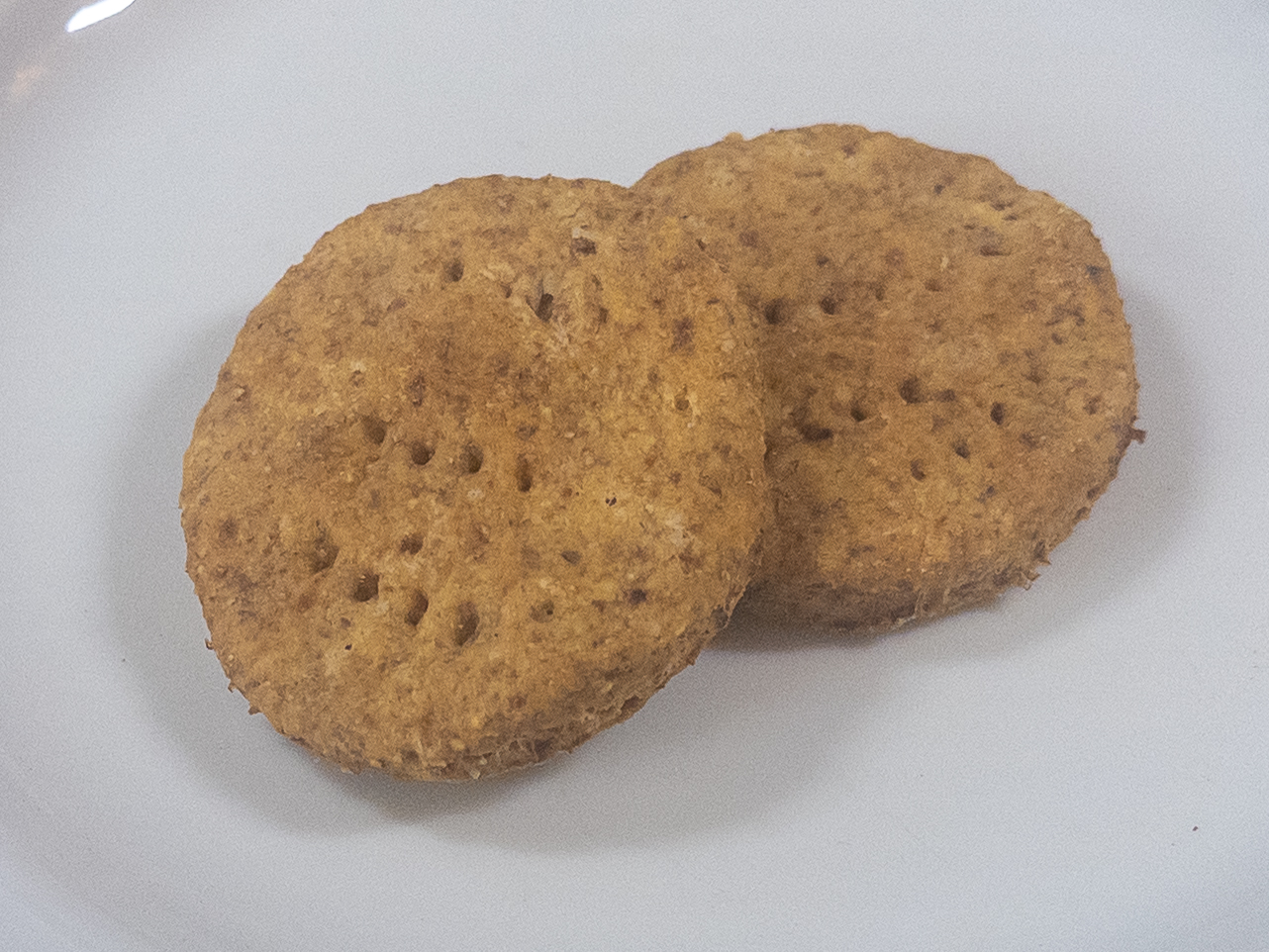
I’ve still got ideas for improvement, but this recipe is very promising:
75g (50% total flour weight) Unbleached bread flour
75g (50% total flour weight) Whole wheat flour
98g (65% total flour weight) Water
30g (20% total flour weight) Coconut oil
4g (2% total flour weight) Sugar
4g (2% total flour weight) Salt
4g (2% total flour weight) Baking powder
Mix everything together, knead, roll to 1/8-1/4″ or so, cut into squares/circles, poke some holes like you see in crackers, bake at 350F 20min a side. Feel free to bake longer, I’m still working out the ideal time. Thicker crackers definitely take longer.
Many folks such as civil war re-enactors or others who are concerned with historical accuracy will point out that I’m not really making hard tack any more, but instead just sort of a hard cracker. Well, that’s true. While I need it to stay edible in my pantry for perhaps months, or in my pack for a week or so, I don’t need to ship it around the world in casks or have it toted around battlefields. I’m happy to give up years of shelf life and some sturdiness in exchange for edibility.
I will continue to tweak the recipe, with future plans of adding psyllium husks to up the fiber content, increasing the size and also the thickness get closer to 100kcal, and resting the dough to improve flavor.

